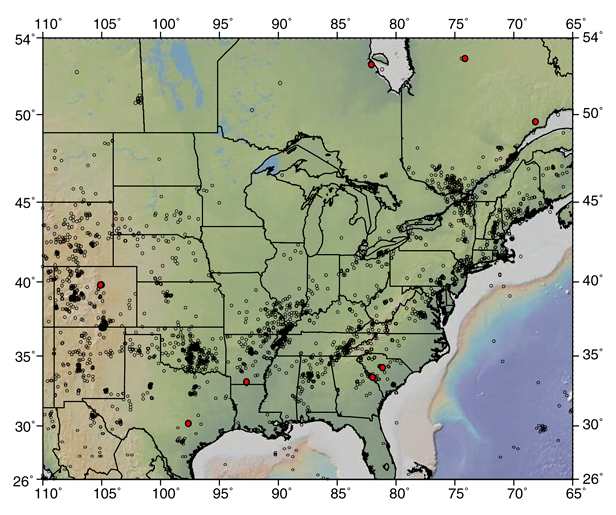Researchers say Earthquakes Would Let Stored CO2 Escape

The authors of a paper published today in the Proceedings of the National Academy of Sciences say that large-scale carbon capture and storage (CCS) is unlikely to work because it would trigger earthquakes that could free the trapped greenhouse gas from the ground.
The paper is a blow to hopes that sequestration could become a big part of future climate strategy. The lead author of the paper is Stanford researcher Mark Zoback, a well-respected expert on the seismic risks of oil and gas production. Steven Gorelick, a Stanford hydrologist, is coauthor with Zoback.
Only last week, the International Energy Agency said that CCS will need to contribute over a fifth of the emissions reductions needed by 2050 to ensure an 80 percent chance of limiting the long-term average global temperature increase to 2 °C.
The oil and gas industry already uses techniques that are similar to CCS during resource extraction and wastewater disposal, and these processes are known to induce small earthquakes. Wastewater injection has been blamed for recent earthquakes in Arkansas, in Ohio, and near the border of Colorado and New Mexico.
Zoback says the risks associated with such quakes can be managed through careful site selection, but large-scale CCS could be more problematic. “You have to be far more restrictive” when choosing a carbon dioxide repository, he explains, since the task is to “keep a buoyant fluid in place for hundreds to thousands of years.”
The paper comes just a few days after a report on the earthquake risks posed by various energy technologies, including oil and gas extraction, wastewater disposal, geothermal power, and CCS, was published by the National Research Council. That report said that “CCS may have the potential for significant seismic risk” and added that “insufficient information exists to understand this potential.”
Zoback and Gorelick’s paper notes that if CCS is to significantly affect atmospheric greenhouse-gas accumulation, it must be able to contain about 3.5 billion tons of carbon dioxide per year worldwide—an amount similar in volume to the nearly 30 billion barrels of oil the world produces annually.
The most promising storage containers are called deep saline aquifers—rock formations one to three kilometers underground, below the depth of freshwater aquifers, and beneath a layer of impermeable rock called the caprock, which acts as a seal. A modeling study by MIT researchers, published earlier this year in PNAS, estimated that deep saline aquifers in the United States could hold at least a century’s worth of the carbon dioxide produced by the nation’s coal-fired power plants.
But this hypothesis has not been tested on a large scale, and Zoback doubts that some of the target storage sites could safely hold as much carbon dioxide as assumed. Even small quakes could damage caprocks, say Zoback and Gorelick. That would threaten the integrity of carbon dioxide repositories, potentially allowing the greenhouse gas to escape into the atmosphere.
Ruben Juanes, a geoscientist and professor of energy studies at MIT, who coauthored the previous PNAS study on carbon dioxide storage capacity in the United States, says the data are too sparse to support Zoback and Gorelick’s sweeping conclusion.
“Currently, there are no models that can forecast the occurrence or magnitude of seismic events caused by fluid injection into the subsurface,” Juanes says. And there is “little field experience to inform the risk” of CCS, since no current projects operate at the scale needed to significantly offset carbon dioxide emissions.
Further, says Juanes, damage to a caprock wouldn’t allow carbon dioxide to escape in all cases. For example, he notes that the Mount Simon Sandstone, a candidate repository in the Illinois Basin, lies beneath at least two caprocks besides the primary one.
Zoback and Gorelick agree that the Mount Simon Sandstone could be a viable carbon dioxide container. But they say there could be dangerous seismological consequences if the region were to rely too heavily on this one location.
“You can find circumstances in which CCS can be done,” Zoback says. “It’s just the enormous scale that is challenged.”
Keep Reading
Most Popular
Large language models can do jaw-dropping things. But nobody knows exactly why.
And that's a problem. Figuring it out is one of the biggest scientific puzzles of our time and a crucial step towards controlling more powerful future models.
How scientists traced a mysterious covid case back to six toilets
When wastewater surveillance turns into a hunt for a single infected individual, the ethics get tricky.
The problem with plug-in hybrids? Their drivers.
Plug-in hybrids are often sold as a transition to EVs, but new data from Europe shows we’re still underestimating the emissions they produce.
Stay connected
Get the latest updates from
MIT Technology Review
Discover special offers, top stories, upcoming events, and more.